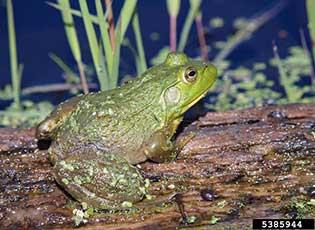Lithobates catesbeianus (formerly known as Rana catesbeiana) (ITIS)
American Bullfrog
Central and Eastern U.S. (Clarkson and deVos 1986)
First introduced to the Western U.S. in the early 1900s (Clarkson and deVos 1986)
Most introductions have been associated with escapes from aquaculture operations. Other pathways include bait used for recreational fishing and escapes or releases through the pet trade, landscape ponds, research, and teaching (Adams and Pearl 2007).
Competes with and preys on native species (Ficetola et al. 2007)
Western U.S.

American bullfrog, adult
Photo by Russ Ottens; University of Georgia
Find more images
Distribution / Maps / Survey Status
All Resources
Selected Resources
The section below contains highly relevant resources for this species, organized by source.
Council or Task Force
Partnership
Federal Government
State and Local Government
Adams M.J., and C.A. Pearl. 2007. Problems and opportunities managing invasive Bullfrogs: is there any hope? In: Gherardi, F. (eds) Biological invaders in inland waters: Profiles, distribution, and threats. Invading Nature - Springer Series In Invasion Ecology, vol 2. Springer, Dordrecht.
Clarkson, R.W. and J.C. de Vos, Jr. 1986. The bullfrog, Rana catesbeiana Shaw, in the Lower Colorado River, Arizona-California. Journal of Herpetology 20(1):42-49.
Ficetola, G.F., W. Thuiller, and C. Miaud. 2007. Prediction and validation of the potential global distribution of a problematic alien invasive species - the American bullfrog. Diversity and Distributions 13(4):476-485.
Integrated Taxonomic Information System. Lithobates catesbeianus. [Accessed Mar 4, 2023].
